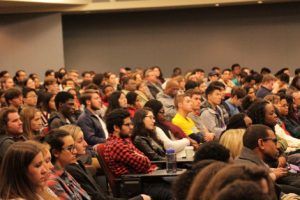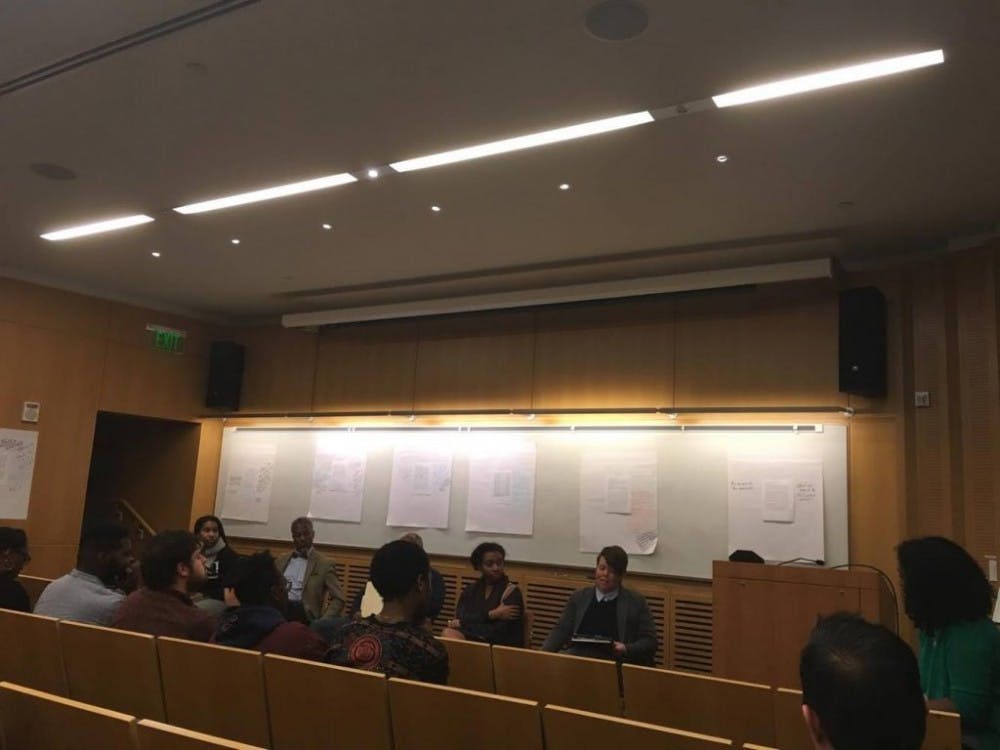A panel of students, faculty and administrators gathered on Thursday, Feb. 16 to discuss the University’s updated Roadmap on Diversity and Inclusion, which was released last November.
While student and faculty panelists criticized the document for not doing more to directly address racial inequality, the University defended its efforts, but admitted that its work is incomplete.
Shani Mott, a lecturer in the Center for Africana Studies and the panel’s moderator, opened the event by outlining the historical context of the Roadmap. She referred back to the Black Student Union’s (BSU) protest and the subsequent Black Student Forum in the fall of 2015, where the BSU listed a series of demands to the University.
These demands included cultural competency classes, an increase in the number of full-time black faculty members, programs focused on the welcoming and retention of black students and that the University cease to use black bodies to promote its public image.
Excerpts from the Roadmap were also pasted on large posters on the walls of the event room. Prior to the panelists speaking, audience members were given markers and invited to write their thoughts about the Roadmap on the posters. Many of these comments were critical of the Roadmap’s wording and questioned the intentions behind some of the listed programs.
Panelist and retired faculty member of the Center for Africana Studies Floyd Hayes specifically criticized the use of the term “diversity,” arguing that it diverts attention from the racism experienced by black students, faculty and workers at Hopkins.
“My association with ‘diversity’ is that it is a source of celebration. We all are diverse,” Hayes said. “I don’t think that term deals with racial power. It does not deal with anti-black racism or white supremacy, and so I think that the term is an evasion.”

Co-Chair for Students for a Democratic Society (SDS) Chase Alston appreciated how the Roadmap encompasses equality for those of all backgrounds on campus. Yet, she echoed Hayes’ point and said that the document fails to address issues specific to black students on campus.
“I like that there has been a Roadmap for all students, but I also think that using diversity to mask the specific things happening to people of black descent on campus is disrespectful for the people who originally brought forth these issues,” she said.
Alston also expressed disappointment by saying how the conversation about race at Hopkins never seems to generate substantive improvements.
“What interests me the most is how cyclical things have been,” Alston said. “There will be a lot of activism and people pushing for change, then things die down again. This repeats every five or 10 years, and there’s no real gain. The University, however, still continues to make profit and remain the overarching winner in the entire situation.”
BSU President Tiffany Onyejiaka argued that the Roadmap failed to address the challenges black students face on campus.
“The quality of life for black students on campus is very rarely discussed in the Roadmap,” Onyejiaka said. “A vast majority of black students at Hopkins have had negative experiences on campus. They are not very happy with their experiences. Students as early as first semester freshmen have addressed these issues.”
Onyejiaka said that this was due to many factors including comments from faculty who she said were not culturally sensitive to students.
“Certain students feel that they can’t celebrate their blackness without feeling that they may be attacked,” Onyejiaka said. “Creating a culture where black students don’t feel so separated is important, since as a whole I continue to hear that students are not happy with their experience.”
Alston referred back to one of the BSU’s demands where they called for the University to stop using images of black students in their admissions advertisements by saying that the portrayals are not an accurate representation of the black student experience. She also explained how this is reminiscent of the way black people have been taken advantage of by the University.
“The commercialization of black bodies in different settings and using them to get more students and faculty for University profit without addressing their needs is an issue,” Alston said. “Not only has that continued, but it’s been something that highlights a long history of exploitation of black bodies.”
Hayes criticized the racial barriers that he said prevent the hiring of black faculty.
“Racism has continued,” he said. “Since coming to Hopkins in 2004, I have urged for the recruitment and hiring of black professors, only to be laughed at by deans and faculty members who suggested the impossibility of this task.”
Interim Chief Diversity Officer James Page spoke on behalf of the administration. He acknowledged that Hopkins has had a history of racism but that they have made significant strides since then.
“Mr. Hopkins and his family set free their slaves and went poor,” Page said. “His family decided to step up and do something that was unusual at the time.”
However, Page believes that the current situation at Hopkins does not reflect the original principles of the institution and that there is still work to be done.
“The challenge is not whether or not [racism] is part of our roots. The challenge is not in the foundations,” he said. “The challenge is that we have not lived up to the bar that was set so many years ago.”
The panel also spoke about the relationship between Hopkins and the greater Baltimore community. Alston specifically addressed the ongoing struggle between the Student Labor Action Coalition (SLAC) and the University. She brought up the issue of minimum wage for contract workers at Hopkins, many of whom are Baltimore locals and African American.
“The $15 minimum wage has been disregarded. Meetings were promised but the meetings have mysteriously disappeared. There has been racism from the administration,” Alston said. “These people have been putting in work for decades but do not have anything to bring back home... It is something that everyone is aware of, but they will not address it now because they don’t think it’s an immediate issue.”
Panelist Abby Neyenhouse, assistant director of the Center for Social Concern spoke about her experience with the Baltimore community in managing the Community Impact Internships Program (CIIP). She addressed the hostile relationship she noticed between the University and the Baltimore community.
“There was push back from community partners that were really skeptical of having undergraduates work with them and just reinforcing the ‘typical Hopkins,’” Neyenhouse said. “There are concerns that we might just be doing research on the community, not sharing information with the community, and that we might be looking for something that might make our students look good but not benefit the organization.”
Neyenhouse was particularly concerned with the “Engaging with Baltimore” section in the Roadmap on Diversity document. She felt that the section, which promises economic inclusion and partnerships with local public schools, failed to explain who exactly the programs benefited.
“I would say that one of the central themes to address is: Who are the programs for?” Neyenhouse said. “Are we engaging with Baltimore as a way for the University to look better or in authentic ways to improve the state of the city for the members that are there?”
Regarding the Roadmap as a whole, Page recognized that there were limitations as to what the document could achieve but that it was a step in the right direction.
“Despite these efforts, however, it is impossible to stop racism,” Page said. “People are going to have prejudice. What we have to realize is how we can get to these things before they surface and damage people who are important within our community.”
Alston hesitated to praise the Roadmap.
“I understand the point of celebrating progress, and celebrating the work that’s been done,” she said. “I think it continues the legacy of exploitation that Hopkins has had with the community.”
Nathan D. Connolly, associate professor of history, was an audience member for the panel. He spoke about how there are terms other than “diversity” that are used to avoid addressing racial issues.
“We must be careful, though, not to get derailed by vague commitments to ‘Academic Freedom,’ a term that comes up often in the Roadmap,” Connolly wrote in an email to The News-Letter. “In its historical use relative to school desegregation efforts, ‘Academic Freedom’ represents a conservative fig leaf meant to preserve and conceal racial inequities in intellectual investment and institutional representations. The term actually appears more than the term ‘racism’ in the Roadmap.”
Connolly also urged people to become more involved in discussions surrounding race as a way to make a community that better addresses racism.
“We have a lot of people who are not actively engaged,” he wrote. “There are voiceless by choice. We need to wake those people up and figure out they can help us create the kind of environment that we need to create.”
Junior Maliha Choudhury explained that she went to this event as a way to join the ongoing discussions about race.
“The University is an influential institution and I wanted to learn more about the JHU Roadmap for Diversity and Inclusion and its weaknesses and strengths,” she said.





